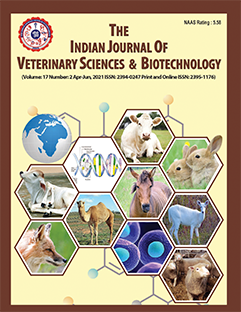Behavioural and Physiochemical Dynamics of the Canine Estrous Cycle: A Tool for Enhancing Breeding Efficiency
DOI:
https://doi.org/10.48165/ijvsbt.21.6.08Keywords:
Behavioural changes, Bitches, Estrous cycle, Physiochemical changesAbstract
Efficient canine breeding relies on accurate detection of the fertile window, particularly during proestrus and estrus. Over the last decade, the interest in high-quality pedigree dogs as pets has surged, driven by smaller family structures and increased awareness. As dog breeding has transformed into a blend of passion, artistry, and science, finding the optimal times for conception and breeding requires constant effort. The present study was conducted during July to December 2024 at Jaipur (Rajasthan) to evaluate the behavioural and physiochemical changes occurring throughout the estrous cycle in bitches to enhance their breeding efficiency. Eighteen healthy bitches, aged 2-4 years, were assessed for behavioural changes (like aggression, tendency to run away from home, frequent urination and flagging of tail, lordosis reflex) and physiochemical parameters (vulvar turgidity, edema, mucous membrane color, vaginal discharge, and vaginal pH). Tail deflection and lordosis emerged as the most consistent behavioural signs of estrus. Vulvar turgidity and edema peaked mid-cycle, while vaginal discharge and pH showed a decreasing trend toward ovulation. Though these external indicators offered valuable guidance, individual variability limited their reliability. Therefore, combining behavioural and physiochemical assessments provided a practical, low-cost recommendation for breeders and veterinarians to improve estrus detection and breeding efficiency, especially where hormonal assays are not accessible. This integrated method could significantly improve timing for natural mating or artificial insemination in domestic dogs.
Downloads
References
Antonov, A.L., Dineva, J., & Geotgiev, P. (2014). Dynamics of vaginal pH in the bitch during proestrus and estrus. Animal and Veterinary Sciences, 2(4), 101–104.
Concannon, P.W. (2011). Reproductive cycles of the domestic bitch. Animal Reproduction Science, 124(3-4), 200–210.
Ese, O.C., Adejo, A.D., Azubuike, U.S., Kwinjoh, C.P., & Owoicho, A.K. (2018). Validation of age at puberty of Nigerian bitches. Animal and Veterinary Sciences, 6(1), 6–11.
Fay, J., Mező, T., Solti, L., Wölfling, A., & Abonyi-Tóth, Z. (2003). Comparison of different methods used for estrus examination in the bitch. Acta Veterinaria Hungarica, 51(3), 385–394.
Feldman, E.C., & Nelson, R.W. (2004). Canine and Feline Endocrinology and Reproduction (3rd ed.). WB Saunders, Philadelphia, USA.
Fesseha, H., & Degu, T. (2020). Estrus detection, estrus synchronization in cattle and its economic importance. International Journal of Veterinary Research, 3(1), 1001.
Goodman, M. (2001). Ovulation timing: Concepts and controversies. Veterinary Clinics: Small Animal Practice, 31(2), 219–235.
Groppetti, D., Aralla, M., Bronzo, V., Bosi, G., Pecile, A., & Arrighi, S. (2015). Periovulatory time in the bitch: What’s new to know?: Comparison between ovarian histology and clinical features. Animal Reproduction Science, 152, 108–116.
Haji, M., Ahmed, F., Lalrintluanga, K., Talukdar, D., Doley, P., Behera, S., & Sarma, K. (2018). The role of estrogen and progesterone hormone on vaginal cytology in bitches. International Journal of Livestock Research, 8(9), 241–247.
Jaller, K., Krishnaswamy, A., Chandrshekeramurthy, V., Narayanaswamy, M., & Sudha, G. (2017). Study on conception rate in bitches following mating at different intervals after optimum vaginal cornification. International Journal of Livestock Research, 7(6), 44–49.
Jayasudha, B., Raju, K.G., Reddy, K.C.S., & Nagaraj, P. (2020). Exfoliative vaginal cytology, vaginal pH and vaginal electrical resistance in spontaneous and induced estrus: A comparative study to predict fertility in bitches. The Indian Journal of Animal Reproduction, 40(2), 37–40.
Kudalkar, S.D., Ingawale, M.V., Pawshe, C.H., Hajare, S.W., Ingole, R.S., & Waghmare, S.P. (2020). Efficacy of exfoliative vaginal cytology and progesterone assay on fertility in bitches. World Journal of Veterinary Science, 8, 36–39.
Kustritz, M.V.R. (2012). Managing the reproductive cycle in the bitch. Veterinary Clinics: Small Animal Practice, 42(3), 423–437.
Labib, F.M., Mansour, H.H., Mahdy, A.B., & Abdallah, A.A. (2018). Predicting the optimal time of breeding and the possible approaches for treatment of some estrus cycle abnormalities in bitches. Slovenian Veterinary Research, 55(suppl20), 125–135.
Layek, S.S., Mohanty, T.K., Kumaresan, A., Behera, K., & Chand, S. (2011). Behavioural signs of estrus and their relationship to time of ovulation in Zebu (Sahiwal) cattle. Animal Reproduction Science, 129(3-4), 140–145.
Maksimović, A., Pehar, B., Filipović, S., & Čengić, B. (2025). The estrous cycle in bitches: Mechanisms, influencing factors, and clinical relevance. Veterinaria, 74(2), 131–142.
McRae, G., Runcan, E., & Johnson, A. (2025). Estrous cycle manipulation in dogs. Clinical Theriogenology, 17, 82–86.
Nagashima, J.B., & Songsasen, N. (2021). Canid reproductive biology: Norm and unique aspects in strategies and mechanisms. Animals, 11(3), 653.
Noakes, D.E., Parkinson, T.J., & England, G.C.W. (2009). Veterinary Reproduction and Obstetrics (9th ed.). WB Saunders Company, London.
Oluwatoyin, O., Ajala, O.E., & Fayemi, M.O. (2012). The oestrous cycle of the Nigerian local bitch. Global Veterinaria, 8(6), 574–582.
Reckers, F., Klopfleisch, R., Belik, V., & Arlt, S. (2022). Canine vaginal cytology: A revised definition of exfoliated vaginal cells. Frontiers in Veterinary Science, 9, 834031.
Romagnoli, S. (2006). Recent advances in canine female reproduction. In Proceedings of World Small Animal Veterinary Association’ World Congress, p. 673–678. https://www.cabidigitallibrary.org/doi/full/10.5555/20073085602
Sharma, A., Singh, M., & Sharma, A. (2022). Correlation between cornification of vaginal epithelial cells and serum progesterone concentration during proestrus and estrus in she dogs. The Indian Journal of Animal Reproduction, 43(1), 57–61.
Skliarov, P., Holubiev, O., & Mylostyvyi, R. (2022). Determining the optimal insemination time of bitches. Revista Fave. Sección Ciencias Veterinarias, 21(1), 4–4.
Sridevi, P. (2015). Canine Reproduction - The Theory and Practice (1st ed.). Active Ads and Printers, Hyderabad, India. https://www.researchgate.net/publication/329754690
Utomo, B.G.R., Puja, I.K., & Gunawan, I.W.N.F. (2023). Dynamic of vaginal pH and ovary ultrasound imaging of Kintamani Bali bitch during proestrus to estrus phase. International Journal of Veterinary Science, 12(2), 242–247.
Downloads
Published
Issue
Section
License
Copyright (c) 2025 Indian Journal of Veterinary Sciences and Biotechnology

This work is licensed under a Creative Commons Attribution-NonCommercial-NoDerivatives 4.0 International License.




